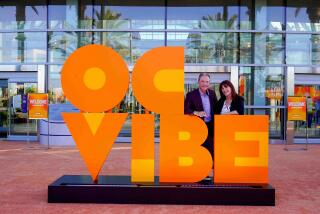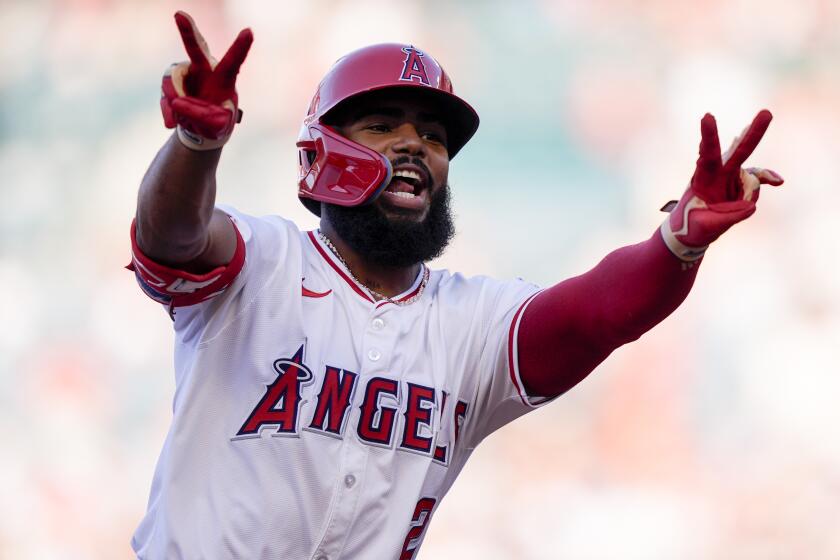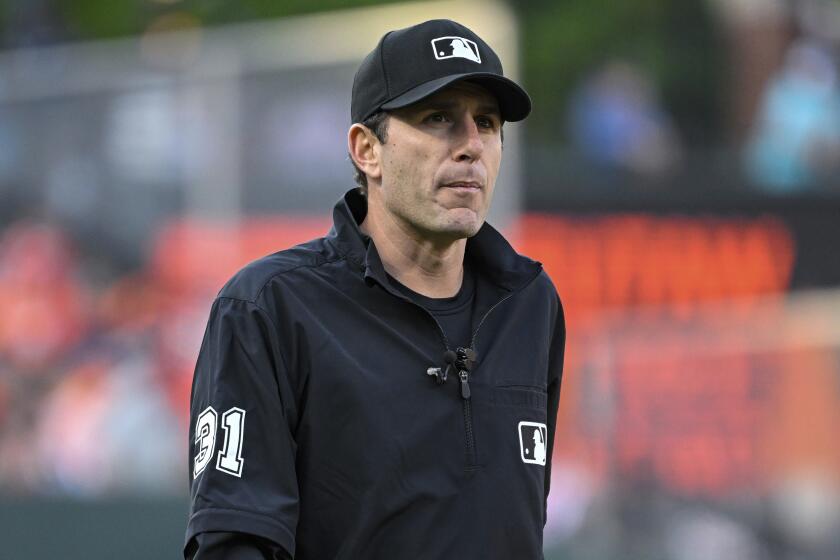There’s More Than Baseball at the Game
- Share via
The crack of the bat I was ready for. The crackle of fireworks I was not. When the first volley hit, during the announcement of the Angels’ starting lineup, it felt as if it exploded just above our table in the outfield dining area at Edison Field in Anaheim.
I thought maybe the fake rock pile was falling behind me. I turned so fast I almost dropped my barbecued chicken leg into the waterfall. The pyrotechnics punctuated a point already clear: There’s more to a trip to the ballpark these days than just taking in a game. There’s flash and fun, exhibits and activities as well as shopping and dining choices to occupy a range of tastes.
The game is still primary, of course--especially when you bring a 9-year-old and a 6-year-old who are devoted fans. But if you’re willing to do some walking, there’s every reason to come early and make a day or evening of it. You might not care if you ever get back.
Keepers of the Fame
My wife, two sons and I arrived when the stadium gates opened at 5:30 p.m. for a 7:05 game because we wanted to get in as much pregame activity as possible. We quickly found that 90 minutes really wasn’t enough time to explore.
Our first destination was the Orange County Sports Hall of Fame, which few people--ushers included--seem to know is on the second level down the right-field line. The hall offers a history of Orange County sports and honors more than 80 inductees, who either grew up in the county or enjoyed success here in college or the pros.
I stopped to view exhibits on two former Anaheim Stadium tenants, the Los Angeles Rams and the Freedom Bowl, but my wife and sons headed straight for the Olympic medals. They found tributes to swimmers Shirley Babashoff, who won eight medals in the 1972 and 1976 Games; Janet Evans, who won four golds in ’88 and ‘92; and Bruce Furniss, who captured two golds in ’76.
Furniss’ USA sweatsuit is displayed, which left the kids wondering: Where’s the swimsuit? They finally decided he had to have something to wear home after he donated his warmups.
Perhaps more than any other event, the Olympics highlight the varied achievements of Orange County athletes. The hall honors each of the dozens of O.C. Olympians who’ve competed over the years, beginning with Fred Kelly, the county’s first gold medalist (1912 high hurdles). Twenty-two local athletes competed in the 1992 Games alone.
Other eye-catching items on display: Ann Meyers’ U.S. national basketball team jersey, Mark Eaton’s size-20 Adidas high tops and John Huarte’s 1964 Heisman Trophy. The Orange County Sports Hall of Fame is open before most Angel home games. An entry donation of $1 is requested.
Take Me Out With the Crowd
We were all getting hungry, but the kids had allowance to spend, so we headed next to the Angels Team Store, on the first level behind home plate. The 4,000-square-foot store was packed with shoppers clamoring to get their hands on a Mo Vaughn “Mo’llennium” cap ($26), an authentic game jersey ($125) or a team jacket ($132).
All those items were out of the boys’ price range, but luckily for them there were plenty of less-expensive options. Who knew there were such things in the world bearing the Angel logo (including more than one kind of bear)?
Sifting through the caps alone could have occupied us till the third inning. The store has dozens of styles, including ones in decidedly non-Angelic shades of orange, yellow and green. My favorite: the cap of the Angels’ Cedar Rapids, Iowa, minor league team, which has as its logo an ear of corn shaped like a baseball.
Across the store, our 6-year-old briefly considered then rejected a tiny Angel-logo glove ($15) that was either a key chain, a rear-view mirror ornament or an infielder’s mitt for a newborn. The boys finally settled on matching sets of Angels trading cards ($5). It mattered little to them that one of the cards was of Jim Edmonds, who had been traded to the Cardinals. “He’s still cool,” the 9-year-old said.
The team store is open game days 10 a.m. to 3 p.m. as well as before and during the game. When the Angels are out of town, it’s open 10 a.m. to 5 p.m.
Not Just Peanuts and Cracker Jack
Next, our exceedingly inefficient tour of the stadium took us back to the second level, this time to the dining and entertainment area behind the mock rocks that rise above the wall in left-center field. Rocks and restaurants are the most notable additions to the stadium during its $115-million renovation before the 1998 season.
The Diamond Club and Knothole Club restaurants--behind home plate and in the right-field corner, respectively--offer upscale dining to suite holders and other club members who prefer crab legs and wine to a hot dog and beer. The Diamond Club even targets its menu to the opponent--barbecue when the Texas Rangers are in town, crab cakes when the Baltimore Orioles visit.
The Knothole Club is more like a high-end sports bar. A favorite dish there is the calamari, served with a spicy Asian chili sauce ($7.95). Also popular is the sushi sampler ($12.95). For the first time this year, the Knothole Club is open to all fans after the sixth inning.
But we weren’t about to wait that long, so we headed to the Gene Autry Smokehouse in dead center field. The half-chicken ($8.25) was moist and tasty and proved a hit even with the kids. The barbecued brisket and pork sandwiches ($6.75 each) were more like swings and misses. We dined alfresco at wooden tables in the shadow of the rocks, built to simulate the California coast.
Across from us, kids lined up at a simulated base path to see how fast they could run 90 feet, the distance from home to first. A digital clock flashed their times next to that of Angels outfielder Darin Erstad, whose best is 3.23 seconds.
As we hurried to finish our meal, the bombs started bursting in air, lifting me from my chair and sending the four of us into a mad dash to try to make it to our seats in the upper deck behind home plate before the first pitch. By the time we got there, we felt as if we’d done laps around the stadium in our pregame quest to see and do everything we wanted. Now all that was left was to enjoy the game.
The Angels fell behind early but tied the score in the third inning with their first hit--a home run by Scott Spiezio. Celebratory fireworks erupted over the rock pile. You know, those things are a lot more fun from afar.
(BEGIN TEXT OF INFOBOX / INFOGRAPHIC)
IF YOU GO
* Getting There: To get to Edison Field, take the Orange Freeway to Orangewood Avenue and go west. Parking is $7; tickets are $3 to $49. Call (714) 940-2000 for more information.
* New Choices, Old Favorites: Other dining options at Edison Field include Chinese cuisine, pasta, gyros and fish and chips. “People want choice, but they still have their favorites,” said Kevin Uhlich, vice president of sales, marketing and operations for the Angels. Hot dogs, peanuts, beer and soft drinks still account for 80% of stadium food sales, he said.
Edison Field
1. Gene Autry Smokehouse
2. Knothole Club
3. Orange County Sports Hall of Fame
4. Diamond Club
5. Angels Team Store
More to Read
Go beyond the scoreboard
Get the latest on L.A.'s teams in the daily Sports Report newsletter.
You may occasionally receive promotional content from the Los Angeles Times.






